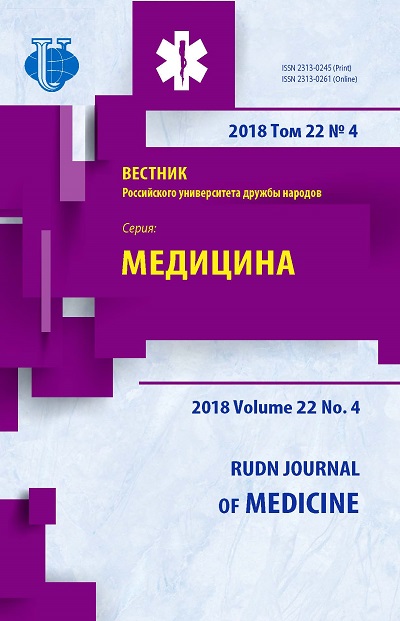THE ROLE OF PUBLIC ORGANIZATIONS IN THE ORGANIZATION OF MEDICAL CARE: ACCORDING TO A SURVEY OF PARENTS OF CHILDREN SUFFERING FROM ORPHAN DISEASES
- Authors: Abramov AY.1, Vitkovskaya IP2,3
-
Affiliations:
- Peoples’ Friendship University of Russia
- Research Institute of Health Organization MM Department of Health Moscow
- Morozovskaya Children's Clinical Hospital of the Moscow Health Department
- Issue: Vol 22, No 4 (2018)
- Pages: 443-449
- Section: SOCIAL HEALTH AND HEALTH PROTECTION
- URL: https://journals.rudn.ru/medicine/article/view/20474
- DOI: https://doi.org/10.22363/2313-0245-2018-22-4-443-449
Cite item
Full Text
Abstract
The activities of public patient organizations are multifaceted: providing legal support to patients in order to protect their legal rights; information and educational work, conducting “schools”, providing specific types of assistance that can provide those involved in the problem. Public patient organizations are the “voice” of all patients with orphan diseases in solving their problems at the level of the highest echelons of power. From 2016-2017 years in the Reference center of congenital hereditary diseases, genetic disorders, orphan and other rare diseases of GBUZ “Morozovskaya DGKB DZM” on a specially designed questionnaire conducted a sociological study on awareness of parents of children suffering ABOUT the public patient organizations. Public organizations provide information and legal support, contact with pharmaceutical companies, participate in solving the problems of patients at the state level. Taking into account the rights and opportunities of public associations, it is necessary for doctors to inform parents about the existence of charitable organizations and their involvement in public patient organizations, as well as to participate in the work of health schools for parents.
About the authors
A Yu Abramov
Peoples’ Friendship University of Russia
Email: vip-dzm@mail.ru
I P Vitkovskaya
Research Institute of Health Organization MM Department of Health Moscow; Morozovskaya Children's Clinical Hospital of the Moscow Health Department
Author for correspondence.
Email: vip-dzm@mail.ru
Head of organizational-methodical Department of Pediatrics GBOU “NIISM DZM”
Bolshaya Sukharevskaya pl., d. 5/1, p. 1, Moscow, 129090 (a/z 68), Moscow, RussiaReferences
- Federal law of 19 may 1995 No. 82-FZ “on public associations” http://constitution.garant.ru/act/right/10164186/.
- Bavisetty S., Grody W.W., Yazdani S. Emergence of pediatric rare diseases. Review of present policies and opportunities for improvement. Rare Diseases. 2013. No. 1 (1). P. 1—5.
- Zakharova E. Rare diseases in Russia. 2012. No. 01. P. 6.
- Zakharova E. Rare diseases in Russia. 2012. No. 01. P. 12—13.
- Eurordis. European organization for Rare Diseases. URL: http://www.eurordis. org/sites/default/files/publications/ fact_Sheet_RD.pdf.
- Priority national project “health” https://ru.wikipedia.org/ wiki/.
- Sokolov A.A., Alexandrova O.Yu. A new model of health care related to rare diseases. Review of legislation in the field of rare diseases in the Russian Federation. Problems of standardization in health care. 2016. № 3—4. P. 10—14.
- Updated report on the implementation and evaluation of the effectiveness of the state program of the Russian Federation “health development” for 2015 https://static-0.rosminzdrav.ru/system/attachments/attaches/ 000/030/367/original/Уточненный_отчет_-_2015.pdf? 1464073627.
- Kagramanyan I.N. Health development strategy. The proceedings of the conference at the HSE 14.04.2017 https://www.rosminzdrav.ru/news/2017/04/14/5327-igor-kagramanyan-prinyal-uchastie-v-obsuzhdenii-strategii-razvitiya-zdravoohraneniya-v-vshe. (accessed 20.07.2017).
- Order of the Department of health of Moscow from 02.06.2015 № 461 “On the organization of the Reference center of congenital hereditary diseases, genetic abnormalities, orphan and other rare diseases”.
- Quick J.D. Ensuring access to essential medicines in the developing countries: a framework for action. Clinical pharmacology & therapeutics. 2008. Vol. 73. P. 279—283.
- Stakisaitis D., Spokiene I., Juskevicius J, et al. Access to informationsupportingavailability of medicines for patients suffering from rare cliases Iooking for possible treatment: the EuOrfan Service. Medicina (Raunas). 2007. № 43 (6). P. 441—446.
- Shabrov R., Shadrin A. Innovations of the legislation on the circulation of medicines. Remedium, 05.04.2017 http://www.remedium.ru/state/detail.php?ID=71271. Date of access 17.09.2018.
- Uvarova Yu.A. Orphan drugs. Remedium. 2011. № 10. P. 29—30.
- Kuznetsov S.I., Bulesheva M.S., Kashaev S.G. Principal aspects of the problem of rare diseases in Russia and in the world. Quality Management of medical care. 2012. № 1. P. 6—13.
- Nosova L.A. Society of patients with rare endocrine diseases “Hope”. Rare diseases in Russia. 2015. No. 01. P. 20—21.
- Kanasheva O.A. Public organizations for rare diseases. Rare diseases in Russia. 2014. No. 01. P. 17.
- Terekhova M.V. All-Russian Society of Rare (Orphan) Diseases. Rare diseases in Russia. 2014. No. 01. P. 19.
















